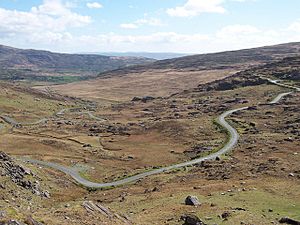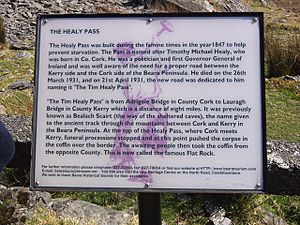R574 road (Ireland) facts for kids
Quick facts for kids
R574 road |
|
|---|---|
| Lua error in Module:Infobox_road/map at line 15: attempt to index field 'wikibase' (a nil value). | |
| Location | |
| Road network | |
|
The R574 is a regional road in Ireland. It is located on the Beara Peninsula and goes over the Caha Mountains through a famous spot called the Healy Pass. This road connects the R572 near Adrigole in County Cork to the R571 close to Lauragh in County Kerry.
The Healy Pass is a very popular place for tourists. It sits high up at 300 meters (about 984 feet). From here, you can see amazing views, like Bantry Bay to the south-east and the Kenmare River to the north-west.
The original path was first called the Kerry Pass. It was built during the Great Famine as a way to help people find work. This was part of a project to give jobs to those who had no other way to get food. The road was later renamed after Timothy Michael Healy, who was a very important person in Ireland. He was the first Governor-General of the Irish Free State and passed away in 1931, shortly after the road was made better. The name "Healy Pass" is now also used for the mountain pass itself. Its old name was Ballaghscart, which comes from the Irish name Irish: Bealach Scairte.
Contents
Building Famine Roads in Ireland
During the Great Famine (1845-1849), many roads were built across Ireland. These roads are often called 'Famine Roads'. They are a lasting reminder of a time when people tried to help, but things often went wrong.
Why Famine Roads Were Built
The idea for these roads came from the government led by Robert Peel. They wanted to improve roads and other structures in Ireland. This would help the economy. At the same time, it would give paid jobs to people who had lost their food source. The potato crop had failed in 1845, leaving many without food or work.
However, the plan did not go as smoothly as hoped. The government wanted local areas to pay for the projects. But there was also a system where the government would pay half. This led to problems, as officials worried that landowners were trying to make money for themselves.
Challenges for Workers
Building these roads was very hard for the workers.
- They often did not have enough tools.
- Many workers were already weak from not having enough food.
- The weather was terrible, especially in the winter and spring of 1846-1847.
- Wages were very low, sometimes as little as three and a half pence a day.
- Payments were often delayed, meaning workers had to wait for their money.
- Officials sometimes suspected that local managers were not strict enough. They wanted fewer people to be hired.
These problems meant that the road-building projects were not really helping people enough. The suffering continued to grow, and eventually, the projects were stopped.
A Sad Story of Hardship
In October 1846, a man named Denis McKennedy from County Cork died while working on a road. He was owed two weeks of wages. It was found that the officials in charge were responsible for his death due to starvation. Sadly, his case was not the only one. Many people faced extreme hardship and even death during these times.
Famine Roads in Stories
The Famine Roads even appeared in books and stories from that time.
- In a book called Castle Richmond (1860) by Anthony Trollope, a character describes seeing men working on a road. They were "half-clad, discontented, with hungry eyes." The story shows how young English engineers were sent to direct the work, even if they did not know much about the area or the conditions.
- Another writer, George Moore, wrote about priests who thought the government's plan was to make sure the work was useless. This was so only the workers would benefit, not landowners. He wrote about roads that "lead nowhere" and how hard it was to get starving men to work on such projects. He felt it was a "humiliation to the people." These stories help us understand the difficult and often frustrating conditions of the Famine Road projects.




